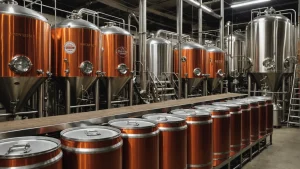Brewery Business Plan Template & PDF Example
- September 4, 2024
- Food & Beverage

Creating a comprehensive business plan is crucial for launching and running a successful brewery. This plan serves as your roadmap, detailing your vision, operational strategies, and financial plan. It helps establish your brewery’s identity, navigate the competitive market, and secure funding for growth.
This article not only breaks down the critical components of a brewery business plan, but also provides an example of a business plan to help you craft your own.
Whether you’re an experienced entrepreneur or new to the food and beverage industry, this guide, complete with a business plan example, lays the groundwork for turning your brewery concept into reality. Let’s dive in!
Our brewery business plan is structured to cover all essential aspects needed for a comprehensive strategy. It outlines the brewery’s operations, marketing strategy , market environment, competitors, management team, and financial forecasts.
- Executive Summary : A quick overview of the Brewery’s concept, market potential, team, and financial strategy.
- Brewery & Equipment: Details on the brewery’s location, equipment, and production capacity.
- Beer Offering & Pricing : Lists beer types, special releases, and pricing strategy .
- Key Stats: Presents the size and growth of the craft brewery market.
- Key Trends : Points out trends like innovative flavors and eco-conscious brewing.
- Key Competitors: Identifies your main competitors and your unique selling points.
- SWOT: A brief analysis of strengths, weaknesses, opportunities, and threats.
- Marketing Plan : Short strategies for promoting the brewery and its beers.
- Timeline : Major milestones from setup to the first year’s end.
- Management: Gives information on the leadership team and their roles.
- Financial Plan: Forecasts the brewery’s finances over 5 years, covering income, expenses, and profitability.


Brewery Business Plan Template (Download)

Fully editable 30+ slides Powerpoint presentation business plan template.
Download an expert-built 30+ slides Powerpoint business plan template
Executive Summary
The Executive Summary presents an overview of your brewery’s business plan, succinctly describing the brewery and its offerings. It will highlight your market positioning, the variety of beers and related products you plan to brew, its location, size, and a snapshot of daily operations.
This section will also delve into how your brewery intends to establish itself within the local market, including an analysis of the number of direct competitors in the vicinity, who they are, and your brewery’s unique selling propositions that set it apart from these competitors.
Moreover, it should outline the management and co-founding team, specifying their roles and how they contribute to the brewery’s success. In addition, a brief on your financial forecasts, including expected revenue and profit margins over the next five years, should be included to offer a transparent view of your brewery’s financial strategy.
Brewery Business Plan Executive Summary Example

Business Overview
The business overview should clearly define the brewery’s key characteristics, including its location, brewing equipment, production volume capacity, and beer offerings. Emphasizing what sets your brewery apart, such as unique flavors or sustainable brewing practices, is crucial for attracting interest and investment.
Example: “CraftHaven Brewery,” nestled in Downtown Riverdale, features a 5,000-square-foot space with a cozy taproom. Equipped with a 10-barrel brewing system, the brewery has an initial production capacity of 2,000 barrels annually, scalable to 5,000 barrels. CraftHaven’s beer lineup, including the popular “Hop Heaven” IPA and “Dark Depths” stout, showcases innovative flavors and seasonal specials, appealing to a wide range of craft beer enthusiasts.
Market Overview
This section should analyze the craft brewery market’s size, growth trends, and competitive landscape . It positions your brewery within the industry and highlights its potential to capitalize on current consumer preferences and market opportunities .
Example: CraftHaven Brewery enters a robust market valued at $28.4 billion, growing steadily at 6% annually. Despite competition from established breweries like Competitor A and B, CraftHaven distinguishes itself with its focus on innovative flavors and commitment to eco-conscious brewing, catering to the preferences of adventurous and environmentally aware customers.
Management Team
Detailing the management team’s background and roles is essential. This part of the summary should emphasize their experience in the craft brewing industry and business management, highlighting their ability to lead the brewery to success.
Example: The Brewmaster, a veteran with years of experience in craft brewing and a graduate of a prestigious brewing program, leads the beer production. The CEO, with an MBA and a strong track record in the food and beverage sector, oversees the brewery’s overall strategy and business operations.
Financial Plan
Clearly outlining the financial goals and projections is key. This section should include targets for revenue and profit margins, offering insight into the brewery’s financial health and growth potential.
Example: CraftHaven Brewery aims to achieve $1.8 million in annual revenue with a 32% EBITDA margin by 2028. Supported by a strategic approach to marketing, quality beer production, and a focus on customer experience, the brewery is positioned for significant growth in the dynamic craft beer market.
For a Brewery, the Business Overview section can be effectively divided into 2 main parts:
Brewery & Equipment
Detail the brewery’s physical setup, focusing on the design, brewing capacity, and the state-of-the-art equipment used in the beer-making process.
Highlight the brewery’s location, emphasizing its accessibility and the convenience it offers to visitors, such as proximity to popular dining or entertainment areas or ease of parking. Discuss why this location is strategically chosen to attract your target market .
Beer Offering & Pricing
Describe the range of beers and related products offered, from classic ales and lagers to innovative craft and seasonal brews. Explain your pricing strategy, ensuring it reflects the quality and uniqueness of your offerings and aligns with the market you’re targeting.
Emphasize any special releases, subscription models, or loyalty programs that add value for your customers, fostering repeat visits and a strong brewery community.

Industry size & growth
In the Market Overview of your brewery business plan, begin by exploring the size of the craft beer and brewing industry along with its growth potential. This analysis is vital for grasping the market’s breadth and pinpointing opportunities for expansion.
Key market trends
Continue by discussing recent trends in the market, such as the growing consumer interest in craft and artisanal beers, the preference for local and sustainable brews, and the innovation in beer flavors and brewing techniques.
Highlight the demand for beers that offer a unique experience, such as those using locally sourced ingredients or those that cater to niche tastes, alongside the increasing popularity of breweries that emphasize environmental sustainability and community engagement.
Competitive Landscape
A competitive analysis is a crucial element in understanding the position of your brewery in the market and is an essential part of your business plan. This analysis aids in pinpointing your brewery’s unique selling points, vital for standing out in a competitive industry.
Moreover, a competitive analysis is fundamental in building a strong foundation for your business plan. By examining the operational aspects of your competitors, you gather valuable information that ensures your business plan is comprehensive, well-informed, and designed to thrive in the brewery market.
Identifying Your Competitors in the Brewing Industry
Identifying competitors is the first step in understanding your position in the brewing market. Begin by mapping out local and regional breweries. For instance, if your brewery specializes in craft beers, your direct competitors include nearby craft breweries as well as larger beer companies that have entered the craft market. Don’t overlook indirect competitors such as local bars or pubs that offer a wide selection of beers, including those from competing breweries.
Use online tools like Google Maps to get a geographical sense of competitor distribution. Platforms like Untappd and RateBeer offer customer reviews and ratings, providing insights into competitors’ strengths and weaknesses . For example, if several reviews praise the unique seasonal brews at “Crafty Ales,” this is a key strength of your competitor.

Brewery Competitors’ Strategies
Analyzing the strategies of these competitors involves several aspects:
- Core Beers : Examine their core beer offerings. If “Hops Haven” is gaining popularity with its diverse IPA range, it indicates a market trend towards hop-forward beers.
- Brewing Techniques : Consider the brewing techniques and styles. A brewery like “Traditional Brews” that focuses on classic styles might appeal to a different customer base than one like “Innovative Brews,” known for experimental and unconventional beers.
- Pricing Strategy : Compare your pricing with that of competitors. Are your beers priced similarly to “Budget Brews” or are they more aligned with the premium offerings at “Exclusive Ales”?
- Marketing Tactics : Look at how competitors market their products. Do they have a strong social media presence like “Social Sips,” or do they rely more on community events and word-of-mouth?
- Customer Experience : Assess the taproom or brewery tour experience. For instance, “Friendly Ferments” might be known for its welcoming atmosphere and knowledgeable staff, enhancing the customer experience.
- Operational Efficiency : Observe if competitors are using technology or innovative processes to streamline brewing and serving, much like “Techie Taps” with its automated brewing system.
What’s Your Brewery’s Value Proposition?
Reflect on your brewery’s unique value proposition . Maybe your brewery is known for using locally sourced ingredients, or perhaps you offer a unique range of barrel-aged beers that aren’t available elsewhere in your area.
Identify market gaps through customer feedback and industry trends. For example, the rising interest in sustainable and eco-friendly brewing practices could represent a market opportunity if competitors are not addressing this demand.
Consider your location: A brewery in a bustling downtown area might focus on creating a vibrant taproom experience, while a rural brewery could capitalize on its scenic location to become a destination for beer tourism.

Begin with a SWOT analysis for the brewery, identifying Strengths (such as a unique beer selection and strong brand identity), Weaknesses (including potential high startup costs or market saturation), Opportunities (for instance, the growing craft beer movement and local food pairing events), and Threats (like changing regulations or economic factors that may impact discretionary spending).

Marketing Plan
Then, formulate a marketing plan that details strategies for drawing in and keeping customers through targeted advertising, special brewery events, an active and engaging social media presence, and involvement in local community events and festivals.
Marketing Channels
Digital marketing.
- Social Media Engagement: In today’s digital era, leveraging various online platforms is critical for establishing a strong brewery presence. Social media platforms like Instagram, Facebook, and Twitter serve as avenues to showcase your brewery’s story, share behind-the-scenes glimpses of the brewing process, and engage with beer enthusiasts.
- Email Marketing: Build an email list for brewery updates, exclusive beer releases, and events. Offer incentives like access to limited-edition beers or discounts for subscribers.
- Website and SEO: A professionally designed website acts as a central hub for all brewery-related information, including beer offerings, taproom events, online merchandise sales, and engaging blog content related to the brewing industry. Optimizing your website for local SEO ensures that your brewery ranks prominently in online searches for beer-related queries within your geographical area.
Local Advertising
- Community Involvement: Community involvement and local outreach efforts are powerful tools for creating brand awareness and fostering connections within your locality. Sponsor local events, participate in community fairs, and collaborate with nearby businesses to expand your brewery’s visibility.
- Print and Media: Print media, including local magazines, newspapers, and strategically placed posters or flyers in local hangout spots, contribute significantly to reaching a broader audience within your vicinity.
Partnerships and Collaborations
- Collaborate with Bars and Restaurants : Forming partnerships and collaborations within the industry can amplify your brewery’s reach and customer base. Collaborate with bars, restaurants, or cafes to feature your brews on their menus or create exclusive beer collaborations.
- Events and Festivals: Participating in events, such as beer festivals or industry expos, allows for networking opportunities and exposure to a wider audience. Collaborate with food vendors or artists during these events to enhance the overall experience for attendees.
Promotional Activities
- Limited Releases and Special Events: Launch limited-edition beer releases or seasonal brews to create buzz and attract beer enthusiasts.
- Loyalty Programs: Implement a loyalty system offering rewards or discounts for frequent taproom visitors or repeat customers.
- Referral Programs: Incentivize customers to refer friends by offering discounts or exclusive access to brewery events.

Sales Channels
Taproom sales.
- Enhance Customer Experience: Train staff to upsell by suggesting beer pairings, recommending merchandise alongside purchases, and educating customers about your brewing process and beer varieties. Create an inviting ambiance in the taproom that aligns with your brewery’s brand, encouraging customers to spend more time and explore various offerings.
- Merchandise Sales: Display branded merchandise prominently and offer it as part of bundled deals or promotions.
Online Sales and Distribution
- E-commerce Platform: Expanding beyond the taproom, establishing an online sales platform broadens your brewery’s reach. Developing a user-friendly e-commerce platform allows customers to purchase your beers, merchandise, and gift cards conveniently from anywhere.
- Local Delivery or Shipping: Consider offering local delivery services or partnering with delivery platforms to ensure timely beer deliveries to customers’ doorsteps. Additionally, explore opportunities for shipping your beers to regions beyond your immediate locality to cater to a broader market.
Membership and Subscription Programs
- Membership Benefits: Create a beer club or subscription model offering members exclusive access to limited-edition releases, discounts on merchandise, or brewery events.
- Subscription Boxes: Curate monthly beer subscription boxes featuring a variety of brews for customers beyond your local area.
Strategy Timeline
Lastly, establish a comprehensive timeline that marks key milestones for the brewery’s launch, marketing initiatives, customer base development, and growth goals, ensuring the business progresses with clear direction and intent.

The Management section focuses on the brewery’s management and their direct roles in daily operations and strategic direction. This part is crucial for understanding who is responsible for making key decisions and driving the brewery towards its financial and operational goals.
For your brewery business plan, list the core team members, their specific responsibilities, and how their expertise supports the business.

The Financial Plan section is a comprehensive analysis of your financial projections for revenue, expenses, and profitability. It lays out your brewery’s approach to securing funding, managing cash flow, and achieving breakeven.
This section typically includes detailed forecasts for the first 5 years of operation, highlighting expected revenue, operating costs and capital expenditures.
For your brewery business plan, provide a snapshot of your financial statement (profit and loss, balance sheet, cash flow statement), as well as your key assumptions (e.g. number of customers and prices, expenses, etc.).
Make sure to cover here _ Profit and Loss _ Cash Flow Statement _ Balance Sheet _ Use of Funds

Related Posts

Steakhouse Business Plan Template & PDF Example
- Business Plan

Bubble Tea Business Plan Template & PDF Example

Bar Business Plan Template & PDF Example
Privacy overview.

Learning center series
Brewery business plan templates and examples [Free and paid]
- Published on August 16, 2024
- by Oguzhan Uyar
- Last updated: 1 month ago
Securing funding for your brewery dream in 2024? It all starts with a rock-solid business plan.
But where do you begin? How do you make your plan stand out from the crowd and convince investors to take a chance on your sudsy vision?
Fear not, aspiring brewery owner. We’ve got you covered with 7 brewery business plan templates that will help you navigate the planning process and impress potential funders.
From crafting a compelling executive summary to nailing your financial projections, these templates will guide you every step of the way.
So grab a cold one, and let’s dive into creating a business plan that will make your brewery dreams a reality.
![Brewery Business Plan Templates And Examples [Free And Paid] - Brewery Business Plan Templates - Brewery Business Plan Templates And Examples [Free And Paid] - Brewery Business Plan Templates -](https://assets.metrobi.com/wp-content/uploads/2024/08/1-4-Brewery-Business-Plan-Templates-That-Will-Secure-Funding-in-2024-1024x576.jpg)
Brewery Business Plan Templates: Key Elements for Success
Creating a comprehensive and compelling business plan is crucial for any aspiring brewery owner seeking to secure funding and establish a successful venture. By incorporating key elements and following a structured template, you can effectively communicate your brewery’s unique value proposition, target market, and growth potential to investors and stakeholders. Learn how to craft an effective plan for your brewery business , ensuring your vision comes to life by understanding what constitutes an impactful brewery business plan.
Executive Summary: Your Brewery’s Unique Value Proposition
The executive summary is the first and most critical section of your brewery business plan. It should provide a concise overview of your brewery’s mission, goals, and unique selling points. This section is your opportunity to capture the attention of potential investors and convince them to read further. Interested in structuring an effective brewery business plan? Learn how to craft a compelling executive summary and other key components for success.
Crafting a Compelling Overview
Begin by stating your brewery’s mission statement, which should encapsulate your core values and long-term objectives. Highlight your brewery’s unique selling points, such as your focus on locally sourced ingredients, innovative brewing techniques, or commitment to sustainability. Clearly define your target market, including demographics, preferences, and buying habits.
Summarizing Financial Projections and Funding Requirements
Provide a brief summary of your financial projections, including revenue, expenses, and profitability over the next 3-5 years. Clearly state your funding requirements and how you plan to allocate the funds to support your brewery’s growth and operations.
TIP: Ensure that your financial projections are realistic and well-researched. Consider using industry benchmarks and consulting with financial experts to validate your assumptions.
Company Description: Showcasing Your Brewery’s Identity
The company description section should provide a detailed overview of your brewery’s history, ownership structure, and physical location. This section helps investors understand your brewery’s background and sets the stage for your future growth plans.
Detailing Your Brewery’s History and Ownership
Begin by outlining your brewery’s history, including when and how it was founded, as well as any significant milestones or achievements. Provide information about the ownership structure, including the names and backgrounds of the key stakeholders and their roles within the company. Eager to ensure your brewery becomes a financial success ? Make sure to revisit and refine your business plan regularly to stay aligned with your profitability goals.
![Brewery Business Plan Templates And Examples [Free And Paid] - Brewery Business Plan Templates - Brewery Business Plan Templates And Examples [Free And Paid] - Brewery Business Plan Templates -](https://assets.metrobi.com/wp-content/uploads/2024/08/2-4-Brewery-Business-Plan-Templates-That-Will-Secure-Funding-in-2024-1024x576.jpg)
Describing Your Brewery’s Location and Facilities
Provide a detailed description of your brewery’s physical location, including the size of the facility, production capacity, and any unique features or amenities. Discuss the advantages of your location, such as proximity to key suppliers, distribution channels, or a thriving craft beer scene.
TIP: Include images or floor plans of your brewery to help investors visualize your facility and production capabilities.
Showcasing Your Brewery’s Core Values and Brand Personality
Discuss your brewery’s core values and how they shape your brand identity and company culture. Describe your brand personality, including the tone, voice, and visual elements that set your brewery apart from competitors. Outline your vision for growth, including plans for expansion, new product lines, or distribution strategies.
![Brewery Business Plan Templates And Examples [Free And Paid] - Brewery Business Plan Templates - Brewery Business Plan Templates And Examples [Free And Paid] - Brewery Business Plan Templates -](https://assets.metrobi.com/wp-content/uploads/2024/08/3-4-Brewery-Business-Plan-Templates-That-Will-Secure-Funding-in-2024-1024x576.jpg)
The average Metrobi driver rating is 4.97 / 5.00
Metrobi drivers are highly rated by local businesses for their professionalism and reliability, giving you peace of mind with every delivery.
Crafting a Winning Brewery Business Plan Outline
Creating a well-structured and engaging business plan outline is crucial for securing funding and guiding your brewery’s growth. A winning outline should cover all essential aspects of your business, from market analysis to financial projections, while being easy to navigate and compelling to potential investors.
Market Analysis: Understanding Your Target Audience and Competition
Conducting thorough market research is the foundation of a solid business plan. Start by identifying your target audience, including their demographics, preferences, and buying habits. Analyze consumer trends in the craft beer industry, such as the growing demand for unique flavors and local offerings.
Next, evaluate your competition at both local and regional levels. Identify their strengths and weaknesses, and look for opportunities to differentiate your brewery. Consider factors such as their product offerings, pricing, taproom experience, and distribution reach.
Conducting Market Research
Survey potential customers to gather insights on their preferences and expectations
Attend local beer festivals and events to observe consumer behavior and trends
Analyze sales data and market reports from industry associations and research firms, such as the Craft Beer Market Research Report by IBISWorld
![Brewery Business Plan Templates And Examples [Free And Paid] - Brewery Business Plan Templates - Brewery Business Plan Templates And Examples [Free And Paid] - Brewery Business Plan Templates -](https://assets.metrobi.com/wp-content/uploads/2024/08/4-4-Brewery-Business-Plan-Templates-That-Will-Secure-Funding-in-2024-1024x576.jpg)
Check what a detailed Market Analysis can bring to the table wth this template
Product Line and Services: Showcasing Your Brewery’s Offerings
Your product line is the heart of your brewery business plan. Describe your core beer styles, seasonal offerings, and any limited-edition or experimental brews. Highlight the unique aspects of your products, such as locally-sourced ingredients, innovative brewing techniques, or eye-catching packaging.
In addition to your beer offerings, outline any additional services or experiences your brewery provides. This may include a taproom, beer garden, or event space. Describe how these services contribute to your brand identity and customer loyalty.
![Brewery Business Plan Templates And Examples [Free And Paid] - Brewery Business Plan Templates - Brewery Business Plan Templates And Examples [Free And Paid] - Brewery Business Plan Templates -](https://assets.metrobi.com/wp-content/uploads/2024/08/5-4-Brewery-Business-Plan-Templates-That-Will-Secure-Funding-in-2024-1024x576.jpg)
Marketing and Sales Strategy: Reaching and Engaging Your Target Audience
A comprehensive marketing and sales strategy is essential for attracting customers and driving revenue. Develop a strong brand identity that reflects your brewery’s unique personality and values. Create a marketing plan that includes tactics such as social media campaigns, email marketing, and partnerships with local businesses or events.
Your sales strategy should outline your distribution channels, pricing structure, and sales targets. Consider the balance between on-premise sales (taproom) and off-premise sales (retail distribution). Establish relationships with local bars, restaurants, and liquor stores to expand your reach.
![Brewery Business Plan Templates And Examples [Free And Paid] - Brewery Business Plan Templates - Brewery Business Plan Templates And Examples [Free And Paid] - Brewery Business Plan Templates -](https://assets.metrobi.com/wp-content/uploads/2024/08/6-4-Brewery-Business-Plan-Templates-That-Will-Secure-Funding-in-2024-1024x576.jpg)
Building Your Brand
Design a memorable logo and packaging that stands out on shelves and social media
Develop a consistent brand voice and messaging across all marketing channels
Engage with your audience through storytelling, behind-the-scenes content, and user-generated content, as seen in successful campaigns by breweries like Stone Brewing
By crafting a detailed and compelling business plan outline, you’ll be well-equipped to secure funding and guide your brewery’s growth. Remember to keep your plan concise, visually appealing, and easy to navigate for potential investors and partners.
Mastering Brewery Business Plan Financials
Startup costs and funding requirements: planning for success.
Crafting a detailed breakdown of your brewery’s startup costs is crucial for securing funding and ensuring a smooth launch. Begin by listing all the necessary equipment, such as brewing systems, fermentation tanks, and packaging machinery. Include the costs of any facility improvements or renovations required to accommodate your brewery’s operations. Don’t forget to account for inventory expenses, including raw materials like hops, malt, and yeast.
Developing a Funding Strategy
Once you have a clear understanding of your startup costs, outline your funding requirements and sources. Determine how much personal investment you can contribute and explore additional options, such as business loans or attracting investors. Be realistic about the amount of funding you need and the timeline for securing it.
Average Rates: According to the Nerd Wallet , the average interest rate for business loans range from 6.14% to 12.47% as of July 2024.

Creating a Launch Timeline
Develop a detailed timeline that outlines the steps from securing funding to launching your brewery. Include milestones such as equipment installation, facility preparation, and obtaining necessary licenses and permits. This timeline will help you stay on track and demonstrate to potential investors that you have a well-thought-out plan.
![Brewery Business Plan Templates And Examples [Free And Paid] - Brewery Business Plan Templates - Brewery Business Plan Templates And Examples [Free And Paid] - Brewery Business Plan Templates -](https://assets.metrobi.com/wp-content/uploads/2024/08/7-4-Brewery-Business-Plan-Templates-That-Will-Secure-Funding-in-2024-1024x768.png)
This template will ensure you’re on track for your launch
Financial Projections: Forecasting Your Brewery’s Growth and Profitability
To showcase your brewery’s potential, create a 3-5 year financial projection that includes revenue, expenses, and cash flow. Start by estimating your production capacity and expected sales volume based on market research and competitor analysis. Factor in the costs of raw materials, labor, utilities, and other operating expenses. Use this information to generate projected income statements and cash flow statements.
Identifying Key Assumptions and Drivers
Be transparent about the key assumptions and drivers behind your financial projections. Explain how factors such as production efficiency, pricing strategy, and distribution channels impact your revenue and expenses. Identify potential risks and challenges that could affect your projections, and outline strategies for mitigating these risks. Industry benchmarks suggest that breweries with efficient production processes can reduce costs by up to 15%.
Scenario Planning for Financial Resilience
To demonstrate your brewery’s financial resilience, develop best-case, worst-case, and realistic scenarios. Utilizing scenario planning software can facilitate this process by allowing you to create detailed and dynamic models. The best-case scenario should showcase your brewery’s potential for rapid growth and profitability, while the worst-case scenario should address potential challenges and how you plan to overcome them. The realistic scenario should provide a balanced view of your brewery’s expected performance based on current market conditions and your competitive advantages. A break-even analysis can help illustrate when your brewery will become profitable under each scenario.
By presenting a comprehensive financial plan that includes detailed startup costs, funding requirements, and realistic projections, you’ll be well-positioned to secure the necessary funding and support to launch and grow your brewery business.
Operations and Management: Ensuring Smooth Brewery Operations
Production and quality control: crafting consistently exceptional beer.
A well-designed production process is the foundation of any successful brewery. Start by outlining your brewing process, including the equipment you’ll be using, the ingredients you’ll source, and the quality control measures you’ll implement at each stage.
![Brewery Business Plan Templates And Examples [Free And Paid] - Brewery Business Plan Templates - Brewery Business Plan Templates And Examples [Free And Paid] - Brewery Business Plan Templates -](https://assets.metrobi.com/wp-content/uploads/2024/08/8-4-Brewery-Business-Plan-Templates-That-Will-Secure-Funding-in-2024-1024x576.jpg)
Brewing Equipment and Facilities
Invest in high-quality brewing equipment that can handle your production volume and ensure consistent results. Consider factors such as:
🍺 Brewhouse size and capacity
🍺 Fermentation and conditioning tanks
🍺 Packaging equipment (bottling, canning, or kegging)
🍺 Laboratory equipment for quality control testing
Ingredient Sourcing and Quality
The quality of your ingredients directly impacts the quality of your beer. Develop relationships with reliable suppliers who can provide consistent, high-quality ingredients:
🌾 Malted grains (barley, wheat, rye, etc.)
🌾 Hops (pellets, whole leaf, or extracts)
🌾 Yeast strains (ale, lager, or specialty strains)
🌾 Water (treated or filtered to ensure consistency)
Quality Control and Testing
Implement a robust quality control program to ensure consistency and prevent off-flavors or contamination:
🔎 Regularly calibrate and maintain brewing equipment
🔎 Conduct sensory evaluations at each stage of the brewing process
🔎 Perform laboratory tests (gravity, pH, IBU, etc.) to monitor fermentation and ensure product consistency
🔎 Implement a recall plan in case of any quality issues
Inventory Management and Supply Chain Partnerships: Optimizing Efficiency
Effective inventory management and strong supply chain partnerships are essential for optimizing efficiency and minimizing waste in your brewery operations.
Inventory Management System
Implement an inventory management system to track raw materials, finished products, and packaging supplies:
🍺 Use software solutions (e.g., BeerBoard, Ekos Brewmaster) to monitor inventory levels and automate reordering
🍺 Conduct regular physical inventory counts to ensure accuracy
🍺 Establish par levels for each item to avoid stockouts or overstocking
🍺 Analyze sales data to forecast demand and optimize production schedules
Supply Chain Partnerships
Develop strategic partnerships with suppliers to ensure a reliable and cost-effective supply of raw materials and packaging:
📈 Negotiate long-term contracts with favorable pricing and delivery terms
📈 Collaborate with suppliers on forecasting and production planning to avoid shortages or delays
📈 Explore opportunities for bulk purchasing or group buying with other local breweries to reduce costs
Sustainability and Environmental Responsibility
Highlight your commitment to sustainability and environmental responsibility in your brewery operations:
🌾 Implement water conservation measures, such as reclaiming rinse water or using low-flow fixtures
🌾 Explore energy-efficient equipment and renewable energy sources (e.g., solar panels)
🌾 Develop a waste reduction and recycling program for spent grain, packaging materials, and other byproducts
🌾 Partner with local farmers or food producers to repurpose spent grain as animal feed or compost
🌾 Get inspired by Sierra Nevada’s solar array , which generates 20% of the brewery’s electricity
🌾 Check out New Belgium’s wastewater treatment system : it produces biogas for energy production
By focusing on production quality, management structure, inventory efficiency, and sustainability, you can create a solid foundation for your brewery’s long-term success. These elements demonstrate to investors that you have a well-conceived plan for ensuring smooth and profitable operations.
Appendices and Supporting Documents: Strengthening Your Business Plan
Financial statements and projections.
A strong business plan requires detailed financial statements and projections to demonstrate the viability of your brewery. Include balance sheets, income statements, and cash flow projections for the next 3-5 years. These documents should be based on realistic assumptions and supported by thorough research.
Additionally, provide supporting documentation such as tax returns, contracts, and lease agreements. This level of transparency builds trust with potential investors and lenders, showing that you have a solid understanding of your brewery’s financial health and future potential.
![Brewery Business Plan Templates And Examples [Free And Paid] - Brewery Business Plan Templates - Brewery Business Plan Templates And Examples [Free And Paid] - Brewery Business Plan Templates -](https://assets.metrobi.com/wp-content/uploads/2024/08/9-4-Brewery-Business-Plan-Templates-That-Will-Secure-Funding-in-2024.png)
Learn about your business’ future with this financial projection template
Market Research and Competitive Analysis
Investors want to see that you have a deep understanding of your target market and the competitive landscape. Include relevant market research data, such as industry reports, consumer surveys, and competitor profiles. This information should highlight the demand for craft beer in your area and identify any gaps in the market that your brewery can fill.
Provide a detailed SWOT analysis of your brewery, identifying its strengths, weaknesses, opportunities, and threats. This analysis should demonstrate your ability to capitalize on your unique selling points while mitigating potential risks.
![Brewery Business Plan Templates And Examples [Free And Paid] - Brewery Business Plan Templates - Brewery Business Plan Templates And Examples [Free And Paid] - Brewery Business Plan Templates -](https://assets.metrobi.com/wp-content/uploads/2024/08/10-4-Brewery-Business-Plan-Templates-That-Will-Secure-Funding-in-2024.png)
Learn everything you need to know about your brewery with this SWOT template
Industry Reports and Consumer Surveys
📦 Craft Beer Market Size and Growth Projections
📦 Consumer Preferences and Buying Habits
📦 Local and Regional Market Trends
Competitor Profiles
🍻 Established Breweries in Your Area
🍻 Emerging Craft Beer Brands
🍻 Unique Selling Points and Market Positioning
Product and Packaging Samples
Your brewery’s products and packaging are the face of your brand. Include high-quality images of your beer labels, packaging designs, and merchandise in your business plan’s appendices. These visuals should showcase your brand’s unique identity and appeal to your target audience.
Provide samples of your marketing materials, such as brochures, flyers, and social media content. These materials should demonstrate your ability to effectively promote your brewery and engage with potential customers.
Beer Labels and Packaging Designs
👁️ Unique and Eye-Catching Artwork
👁️ Consistent Branding Across Product Lines
👁️ Sustainable and Environmentally-Friendly Materials
Merchandise and Promotional Items
🛍️ Branded Glassware and Apparel
🛍️ Custom Tap Handles and Signage
🛍️ Promotional Giveaways and Loyalty Program
Legal Documents and Permits
Demonstrating your commitment to compliance and due diligence is crucial when seeking funding for your brewery. Include copies of all necessary legal documents and permits in your business plan’s appendices, such as:
👉 Business License and Registration
👉 Federal Brewer’s Notice (TTB Form 5130.10)
👉 State and Local Alcohol Permits
👉 Food Service Licenses (if applicable)
👉 Lease Agreements or Property Deeds
👉 Insurance Policies
Having these documents readily available shows potential investors and lenders that you have taken all the necessary steps to operate your brewery legally and responsibly.
Personnel and Management Team
Your brewery’s success depends on the strength of your team. Include detailed biographies of your key personnel and management team, highlighting their relevant experience, skills, and qualifications. This section should demonstrate that you have assembled a well-rounded team capable of executing your business plan and achieving your goals.
Founder and Head Brewer
👥 Professional Background and Brewing Experience
👥 Awards and Recognition in the Craft Beer Industry
👥 Vision for the Brewery’s Future
Sales and Marketing Manager
🗣️ Experience in Craft Beer Sales and Distribution
🗣️ Proven Track Record of Building Brand Awareness
🗣️ Strategies for Expanding Market Share
By including these essential appendices and supporting documents, you will strengthen your brewery’s business plan and increase your chances of securing the funding needed to bring your vision to life. Potential investors and lenders will appreciate the level of detail and transparency provided, demonstrating your commitment to building a successful and sustainable craft beer brand.
Your Recipe for Brewery Success
You now have the essential ingredients to craft a compelling brewery business plan that will impress investors and set your brewery up for success. By showcasing your unique value proposition, understanding your target market, and developing a solid financial strategy, you’ll be well on your way to securing the funding you need to bring your vision to life.
Remember, a well-crafted business plan is more than just a document – it’s a roadmap for your brewery’s future. As you navigate the exciting world of craft brewing, refer back to your plan regularly, adjusting and refining as needed to stay on course.
Are you ready to take the next step in your brewery journey? Start by choosing one of the templates we’ve discussed and begin filling in the details of your plan. With dedication, passion, and a solid plan in place, you’ll be pouring your first pint before you know it.
Cheers to your brewing success!
What is a good brewery business plan?
Do you have a profitable brewery? review your business plan

‟With Metrobi, we’re now doing home deliveries in the Greater Boston area”
GrandTen Distilling
‟Metrobi does exactly what I wanted my drivers to do”
LuNo Culinary
‟Trustworthy Drivers ”
Secret Garden Rose
‟Reliable & Consistent”
Wicked Bagel

- Brewery Business Plan
- brewery business plan templates
- profitable brewery

- brewery business plan

- Sustainable Retail Strategies
- Benefits of green logistics for small businesses

- Farm Business Plan
- farm business plan

- Retail Merchandising
- retail merchandising

- Retail Management
- Retail management strategies

- Small Business Employee Benefits
- small business employee benefits

- Credit Cards for Small Businesses
- credit cards for small businesses

- Route Optimization
- travelling salesman problem

- Types of Shipping Methods
- International shipping

- Click and collect shipping

- omnichannel logistics

- dynamic route optimization

- Last Mile Delivery Glossary
- green transportation

Success Stories
Flamingo Estate

Quinlan-Wasserman

Fleurs to You

Diamond Bakery

DELIVER WITH METROBI
Grow with confidence
- Atlanta courier service
- Austin courier service
- Boston courier service
- Chicago courier service
- Denver courier service
- Miami courier service
- New York City courier service
- Los Angeles courier service
- Philadelphia courier service
- San Francisco courier service
- Washington DC courier service
- See all locations
- Driver Network
- Software Only

- [email protected]
- Team Metrobi
- Privacy policy
- Terms of service
- Write for us NEW
Refer us to a company, you earn $250 and they earn $250. Learn more

- Delivery Management Software
- Shopify Delivery Planner App
- Metrobi Delivery API NEW
- Zapiet: Pickup Delivery NEW
- See all integrations
- Metrobi vs. Onfleet
- Metrobi vs. Roadie
- Metrobi vs. Roadie Support
- See all comparisons
- Bulk Order Delivery Service
- Express Urgent Delivery Service
- Fixed Route Delivery Service
- On Demand Delivery Service
- Overnight Delivery Service
- Same Day Delivery Service
- Scheduled Delivery Service
- Wholesale Delivery Service
- See all delivery services
- Artisan Food
- Food Producers
- See all industries
Want to access our large pool of drivers?
We started Metrobi to take operations off your plate. We provide drivers (rated 4.97/5), dedicated operation managers (70% cheaper), and routing software with a receiver notification system.
🥳 Enjoy 14 days of free Metrobi Delivery Support!

How To Write a Successful Brewery Business Plan + Template

Creating a business plan is essential for any business, but it can be especially helpful for brewery businesses that want to improve their strategy and/or raise funding.
A well-crafted business plan not only outlines the vision for your company, but also documents a step-by-step roadmap of how you are going to accomplish it. In order to create an effective business plan, you must first understand the components that are essential to its success.
This article provides an overview of the key elements that every brewery business owner should include in their business plan.
Download the Ultimate Brewery Business Plan Template
What is a Brewery Business Plan?
A brewery business plan is a formal written document that describes your company’s business strategy and its feasibility. It documents the reasons you will be successful, your areas of competitive advantage, and it includes information about your team members. Your business plan is a key document that will convince investors and lenders (if needed) that you are positioned to become a successful venture.
Why Write a Brewery Business Plan?
A brewery business plan is required for banks and investors. The document is a clear and concise guide of your business idea and the steps you will take to make it profitable.
Entrepreneurs can also use this as a roadmap when starting their new company or venture, especially if they are inexperienced in starting a business.
Writing an Effective Brewery Business Plan
The following are the key components of a successful brewery business plan:
Executive Summary
The executive summary of a brewery business plan is a one to two page overview of your entire business plan. It should summarize the main points, which will be presented in full in the rest of your business plan.
- Start with a one-line description of your brewery company
- Provide a short summary of the key points in each section of your business plan, which includes information about your company’s management team, industry analysis, competitive analysis, and financial forecast among others.
Company Description
This section should include a brief history of your company. Include a short description of how your company started, and provide a timeline of milestones your company has achieved.
If you are just starting your brewery business, you may not have a long company history. Instead, you can include information about your professional experience in this industry and how and why you conceived your new venture. If you have worked for a similar company before or have been involved in an entrepreneurial venture before starting your brewery firm, mention this.
You will also include information about your chosen brewery business model and how, if applicable, it is different from other companies in your industry.
Industry Analysis
The industry or market analysis is an important component of a brewery business plan. Conduct thorough market research to determine industry trends and document the size of your market.
Questions to answer include:
- What part of the brewery industry are you targeting?
- How big is the market?
- What trends are happening in the industry right now (and if applicable, how do these trends support the success of your company)?
You should also include sources for the information you provide, such as published research reports and expert opinions.
Customer Analysis
This section should include a list of your target audience(s) with demographic and psychographic profiles (e.g., age, gender, income level, profession, job titles, interests). You will need to provide a profile of each customer segment separately, including their needs and wants.
For example, the customers of a brewery business may include:
- People who live near the brewery
- People who are seeking unique beer flavors or other properties
- People who buy beer from the brewery’s website or through a distributor
You can include information about how your customers make the decision to buy from you as well as what keeps them buying from you.
Develop a strategy for targeting those customers who are most likely to buy from you, as well as those that might be influenced to buy your products or brewery services with the right marketing.
Competitive Analysis
The competitive analysis helps you determine how your product or service will be different from competitors, and what your unique selling proposition (USP) might be that will set you apart in this industry.
For each competitor, list their strengths and weaknesses. Next, determine your areas of competitive differentiation and/or advantage; that is, in what ways are you different from and ideally better than your competitors.
Below are sample competitive advantages your brewery business may have:
- Brewery has a unique brewing process that results in a better-tasting beer.
- Brewery is family-owned and operated; customers can visit the brewery to see how their beer is made.
- Brewery offers a wide variety of beers, which appeals to different customer segments.
- Brewery beers are sold in local restaurants and bars, making it convenient for customers.
- Brewery offers tours of the facilities, which educates customers about the brewing process and creates a memorable experience.
Marketing Plan
This part of the business plan is where you determine and document your marketing plan. . Your plan should be clearly laid out, including the following 4 Ps.
- Product/Service : Detail your product/service offerings here. Document their features and benefits.
- Price : Document your pricing strategy here. In addition to stating the prices for your products/services, mention how your pricing compares to your competition.
- Place : Where will your customers find you? What channels of distribution (e.g., partnerships) will you use to reach them if applicable?
- Promotion : How will you reach your target customers? For example, you may use social media, write blog posts, create an email marketing campaign, use pay-per-click advertising, launch a direct mail campaign. Or, you may promote your brewery business via word-of-mouth marketing.
Operations Plan
This part of your brewery business plan should include the following information:
- How will you deliver your product/service to customers? For example, will you do it in person or over the phone only?
- What infrastructure, equipment, and resources are needed to operate successfully? How can you meet those requirements within budget constraints?
The operations plan is where you also need to include your company’s business policies. You will want to establish policies related to everything from customer service to pricing, to the overall brand image you are trying to present.
Finally, and most importantly, in your Operations Plan, you will lay out the milestones your company hopes to achieve within the next five years. Create a chart that shows the key milestone(s) you hope to achieve each quarter for the next four quarters, and then each year for the following four years. Examples of milestones for a brewery business include reaching $X in sales. Other examples include adding new brewing equipment, launching a new product line, or opening a new location.
Management Team
List your team members here including their names and titles, as well as their expertise and experience relevant to your specific brewery industry. Include brief biography sketches for each team member.
Particularly if you are seeking funding, the goal of this section is to convince investors and lenders that your team has the expertise and experience to execute on your plan. If you are missing key team members, document the roles and responsibilities you plan to hire for in the future.
Financial Plan
Here you will include a summary of your complete and detailed financial plan (your full financial projections go in the Appendix).
This includes the following three financial statements:
Income Statement
Your income statement should include:
- Revenue : how much revenue you generate.
- Cost of Goods Sold : These are your direct costs associated with generating revenue. This includes labor costs, as well as the cost of any equipment and supplies used to deliver the product/service offering.
- Net Income (or loss) : Once expenses and revenue are totaled and deducted from each other, this is the net income or loss.
Sample Income Statement for a Startup Brewery Business
Balance sheet.
Include a balance sheet that shows your assets, liabilities, and equity. Your balance sheet should include:
- Assets : All of the things you own (including cash).
- Liabilities : This is what you owe against your company’s assets, such as accounts payable or loans.
- Equity : The worth of your business after all liabilities and assets are totaled and deducted from each other.
Sample Balance Sheet for a Startup Brewery Business
Cash flow statement.
Include a cash flow statement showing how much cash comes in, how much cash goes out and a net cash flow for each year. The cash flow statement should include:
- Cash Flow From Operations
- Cash Flow From Investments
- Cash Flow From Financing
Below is a sample of a projected cash flow statement for a startup brewery business.
Sample Cash Flow Statement for a Startup Brewery Business
You will also want to include an appendix section which will include:
- Your complete financial projections
- A complete list of your company’s business policies and procedures related to the rest of the business plan (marketing, operations, etc.)
- Any other documentation which supports what you included in the body of your business plan.
Writing a good business plan gives you the advantage of being fully prepared to launch and/or grow your brewery company. It not only outlines your business vision but also provides a step-by-step process of how you are going to accomplish it.
A well-executed business plan will give you the best chance at success and keep you organized and on track as your brewery company grows.
Now that you understand how to write a brewery business plan, it’s time to get started on yours.
Finish Your Brewery Business Plan in 1 Day!
Wish there was a faster, easier way to finish your Brewery business plan?
With our Ultimate Brewery Business Plan Template you can finish your plan in just 8 hours or less!
Other Helpful Articles
How To Write a Successful Microbrewery Business Plan + Template
How To Write a Craft Beer Store Business Plan + Template
How To Write a Successful Brewpub Business Plan + Template
How To Write a Successful Taproom Business Plan + Template

IMAGES
COMMENTS
Brewery Business Plan Template. Use this free template to easily create a great business plan that organizes your vision and helps you start, grow, or raise funding for your brewery.
To make it easier, we’ve put together a complete guide to writing a brewery business plan. In this guide, we’ll cover: How to write a business plan for your brewery business; The 8 sections of every great brewery business plan; A free business plan template for breweries
Our brewery business plan is structured to cover all essential aspects needed for a comprehensive strategy. It outlines the brewery’s operations, marketing strategy , market environment, competitors, management team, and financial forecasts.
The Brewers Association provides resources for all aspects of a brewery's operations, including a handful on how to create and maintain a business plan. Take a look at the BA resources designed to help you create and maintain a business plan for your brewery.
We’ve got you covered with 7 brewery business plan templates that will help you navigate the planning process and impress potential funders. From crafting a compelling executive summary to nailing your financial projections, these templates will guide you every step of the way.
Create a winning business plan quickly & easily with our Ultimate Brewery Business Plan Template. Complete your business plan and financial model in hours.